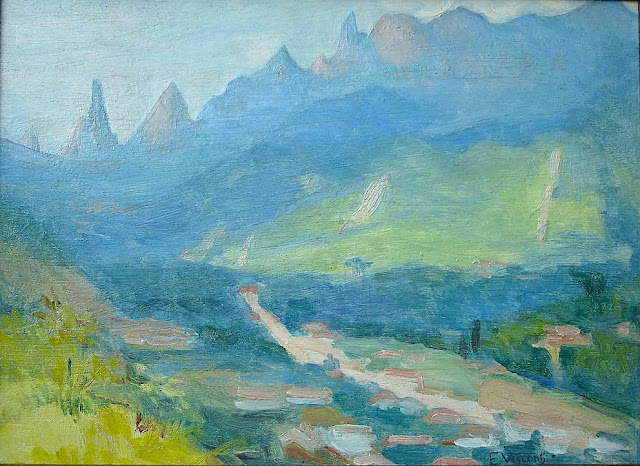Mont Hoffmann (3,307 m)
Etats Unis d'Amérique (Californie)
In View of Schroon Mountain, Essex County, New York, After a Storm , oil on board, 1898,
A propos de ce tableau
Grand défenseur de la nature sauvage américaine, Cole a déclaré : « Nous sommes toujours ici dans l' Eden » dans son Essai sur le
paysage américain, publié deux ans avant de peindre cette vue des
Adirondacks. L'artiste a esquissé la scène au début de l'été, mais
lorsqu'il a créé le tableau dans son atelier, il l'a rendu avec l'éclat
spectaculaire de couleurs automnales. Un tel choix avait probablement des
connotations nationalistes ; il a un jour proclamé que l'automne était «
une saison où la forêt américaine surpasse le monde entier en beauté ». Cole
a inclus deux autochtones dans le feuillage du premier plan
droit du tableau. À cette époque, les Adirondacks étaient encore le foyer de
nombreux Amérindiens longtemps après que la plupart aient été expulsés
de force des terres à l'est du fleuve Mississippi. Tout en continuant à
vivre, chasser et pêcher dans la région, ces peuples algonquins et
iroquois ont été contraints d'adapter considérablement leur existence
au milieu de la colonisation et des industries
forestières, minières et touristiques qui en découlèrent.
La montagne
Le mont Hoffmann (3,307m ) est un sommet de la Sierra Nevada, aux États-Unis.- dans le comté de Mariposa, en Californie, au sein de la Yosemite Wilderness, dans le parc national de Yosemite. Dans Un été dans la Sierra, paru en 1911, John Muir indique avoir randonné jusqu'au sommet du « mont Hoffman » le 26 juillet 1869-. Thomas Cole le surnomme Schrroon Mountain dans ce tableau.
Le peintre
Thomas Cole, est un artiste américain, considéré comme le fondateur de la Hudson River School, école de peinture qui s'épanouit aux États-Unis dans la seconde moitié du A9e siècle.
Les œuvres de Cole et ses amis se caractérisent par leur rendu réaliste
et minutieux des paysages américains, notamment des régions sauvages,
et témoignent à la fois de l'influence du romantisme et du naturalisme. Cole fut avant tout paysagiste, il se consacre également à la peinture
allégorique. La plus célèbre de ces allégories est un ensemble de cinq
toiles, Le Cours de l'Empire (ou Destin des Empires),
qui retrace l'évolution d'un même lieu de l'état sauvage à la naissance
de la civilisation, son développement son déclin et sa mort. Cole a été
inspiré par la lecture de l'Histoire de la décadence et de la chute de l'Empire romain d'Edward Gibbon, publié entre 1776 et 1778. L'œuvre se trouve dans la collection de la Société d'Histoire de New York. En 1827, Cole ouvre un studio dans une ferme à Cedar Grove dans la ville de Catskill, état de New-York. Il exécutera une grande partie de son œuvre dans ce lieu. En 1828, Cooper lui commande un paysage inspiré de ses romans, « sans les feuilles d’automne » du Paysage avec une scène du Dernier des Mohicans dont il juge l'effet trop voyant. Entre 1829 et 1832, il effectue un premier séjour en Europe, visitant notamment Londres, Paris et l'Italie. À Londres, il est attiré par les œuvres des paysagistes Turner et Constable. À Paris, il découvre les paysages classiques du 17e siècle et sera influencé par les œuvres de Claude Lorrain. En 1836, Cole épouse Maria Bartow, une des nièces de son propriétaire, faisant de Catskill son lieu de résidence principal. La jeune femme avait alors 23 ans et lui 35. Cole, qui s'intéressait également à l'architecture à une époque où cette profession était moins réglementée qu'aujourd'hui, participe au concours organisé en 1838 pour la construction du siège de l'exécutif à Columbus. Son projet obtint la troisième place et le monument final est une synthèse entre les projets des trois premiers lauréats. Le premier fils du couple, Theodore Alexander Cole, est né le 1er janvier de cette même année. L'année suivante naît Mary Bartow Cole, le 23 septembre 1839. Cole effectue alors un second séjour européen, d-e 1841 à 1842, accumulant les dessins et les esquisses dont il tirera les tableaux peints plus tard dans son studio de Catskill. Il exerce une influence significative sur ses pairs, notamment sur Asher Brown Durand, Jasper Francis Cropsey et Frederic Edwin Church. Ce dernier fut d'ailleurs son élève de 1844 à 1846.
______________________________________
2024 - Gravir les montagnes en peinture
Un blog de Francis Rousseau
-%20Schroon%20Mountain%20,%20Adirondacks%201838.png)
%20Mt.%20Katahdin%20(1941)%20Oil%20on%20fiberboard,%2055.9%20x%2071.1%20cm.%20Hirshhorn%20Museum%20and%20Sculpture%20Garden,%20Washington%20DC.jpg)

%20-%20Acropolis%20-%20Parthenon_(1871)_MET%20new%20Yprk.jpg)
-%20Casthill%20Mountain%20House%20,%20The%204%20elements%201843-44.png)
%20Medium:%20Brush%20and%20oil%20on%20thin%20board..jpg)









